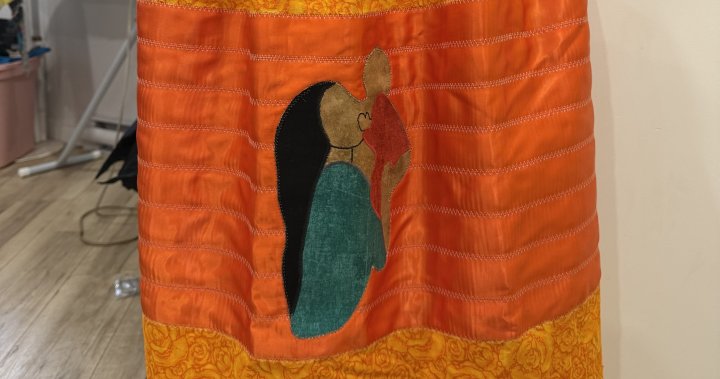The Resurgence of the Ribbon Skirt: A Symbol of Identity, Resilience, and Cultural Reclamation
The ribbon skirt, a vibrant and meaningful garment, has become a powerful symbol of Indigenous identity and cultural resurgence in Canada. For residential school survivors like Rita Martin, the ribbon skirt represents far more than just clothing; it’s a tangible connection to her heritage, a reclaiming of what was stolen, and a vibrant expression of her Indigenous womanhood. Decades passed before Martin donned her first ribbon skirt, a handmade creation crafted with the loving assistance of her granddaughter. The skirt, adorned with the image of a mother and child, draws inspiration from the Every Child Matters movement, a poignant reminder of the tragic legacy of residential schools and the enduring strength of Indigenous families. Wearing the ribbon skirt, Martin experiences a profound sense of pride, a reconnection to her identity as an Indigenous woman, and a reclamation of her cultural heritage. This resurgence of the ribbon skirt is not just a personal journey for Martin; it’s part of a larger movement to celebrate Indigenous culture and resilience.
January 4th is now recognized as National Ribbon Skirt Day in Canada, a testament to the growing awareness and appreciation of Indigenous traditions. This day of recognition was established following an incident in Saskatchewan where student Isabella Kulak faced criticism for wearing a ribbon skirt to school on a formal day. The incident, while unfortunate, sparked a national conversation about the significance of the ribbon skirt and its importance in Indigenous communities. The National Ribbon Skirt Day Act further solidifies the garment’s significance, recognizing it as a symbol of womanhood and a direct connection to Mother Earth. The ribbon skirt’s flowing design, often adorned with vibrant ribbons and meaningful embellishments, evokes a sense of connection to the land and the natural world, reflecting the deep spiritual connection Indigenous peoples have with their environment. The act not only acknowledges the cultural importance of the ribbon skirt but also serves as a powerful statement of support for Indigenous rights and cultural expression.
Within Indigenous communities across Canada, ribbon skirts hold a special place, worn at significant events like weddings and funerals. For Martin, the ribbon skirt is an essential part of traditional ceremonies, particularly the sweat lodge, where it is considered mandatory attire for women. The skirt’s presence in these sacred spaces underscores its connection to spirituality and cultural practices passed down through generations. Martin, the owner of Baby Barn Fabrics, is now actively involved in creating and selling ribbon skirts, driven by a deep desire to share her culture with her community, especially her family. Having experienced the pain of cultural loss due to the residential school system, Martin is determined to ensure that future generations have access to their heritage and traditions. She views her work as a way to reclaim what was lost and to empower younger generations to embrace their Indigenous identity with pride.
The story of Rita Martin and the ribbon skirt resonates with the broader narrative of Indigenous resilience and cultural revitalization. The residential school system, a dark chapter in Canadian history, aimed to assimilate Indigenous children, stripping them of their language, culture, and traditions. The impact of this trauma continues to be felt across generations, but the resurgence of cultural practices like ribbon skirt making offers a path towards healing and reclamation. By sharing her skills and knowledge, Martin is not only creating beautiful garments but also fostering a sense of cultural pride and continuity within her community. Her work is a testament to the enduring strength and resilience of Indigenous peoples and their determination to preserve their cultural heritage.
The ribbon skirt’s growing prominence in contemporary society is a reflection of the ongoing efforts towards reconciliation and understanding between Indigenous and non-Indigenous Canadians. The conversations sparked by events like Isabella Kulak’s experience and the establishment of National Ribbon Skirt Day have created opportunities for learning and dialogue. More and more Canadians are becoming aware of the significance of the ribbon skirt and the rich cultural heritage it represents. This increased awareness is crucial for fostering respect and understanding, essential elements in the journey towards reconciliation. As more Indigenous artists and creators share their stories and traditions, the ribbon skirt becomes a powerful symbol of hope and a reminder of the beauty and resilience of Indigenous cultures.
The ribbon skirt is more than just a piece of clothing; it’s a symbol of identity, resilience, and cultural reclamation. It embodies the strength and spirit of Indigenous women, connecting them to their ancestors and the land. For Rita Martin, it’s a symbol of healing, a way to reclaim what was lost, and a gift to pass on to future generations. The ribbon skirt’s resurgence is a powerful testament to the enduring strength of Indigenous culture and a beacon of hope for a future where all cultures are celebrated and respected. As the ribbon skirt continues to gain recognition and appreciation, it serves as a reminder of the importance of listening to Indigenous voices, learning from their experiences, and working together towards a more just and equitable future.

